Kitchen Utensils - 1916
Anyone who has seen the beautiful kitchen in Washington’s home at Mount Vernon must have been impressed by the great change that has come to the home in the last hundred years in the matter of cooking utensils.
The heavy polished copper vessels suggested a great hotel rather than a home; yet they were the kind and shape that were then in common use. In simpler homes they were made of iron instead of copper, because of the saving in expense.
Today we have the light, attractive aluminum and agate ware, and block tin where aluminum cannot be afforded. The size of utensils is greatly reduced, the variety and number greatly multiplied.
Below are some of the utensils used during the early 1900s.
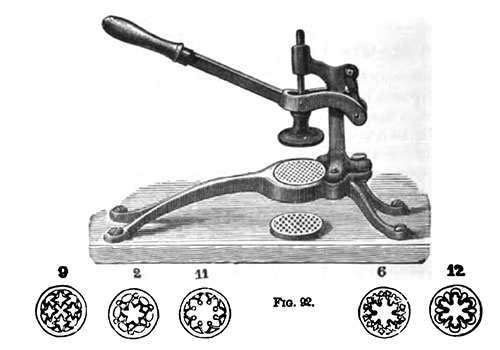
Vegetable Cutter
This utensil is simple, practical and useful. It is used for cutting vegetables and roots into various shapes for soups or garnishing; having them pass by pressure through the deep cutters made of steel and movable so they can be easily changed when so desired.
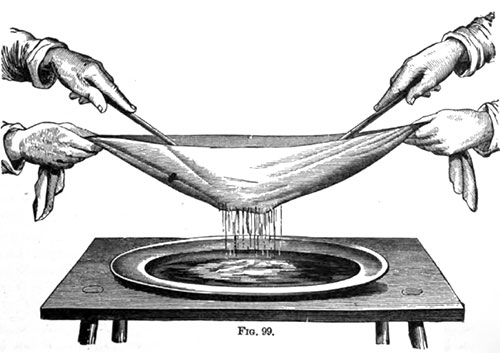
Tammy
Vegetable, chicken, crustacean, and game purées are strained through a tammy in order to obtain a consistency as fine as possible. To accomplish this, it will required the service of two persons: take hold of the tammy on both sides, pour the purée into its hollow center, then have two wooden spoons one laying in the other, and press them vigorously against the tammy, allowing the purée to fall into a deep dish set underneath; this is easily accomplished and depends entirely upon the regular motion of the two spoons, as they must advance backward and forward without getting separated.
Alternatives methods with the machines below:
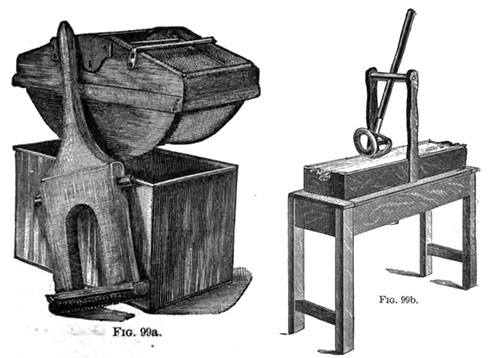
ROASTER AND SPITS
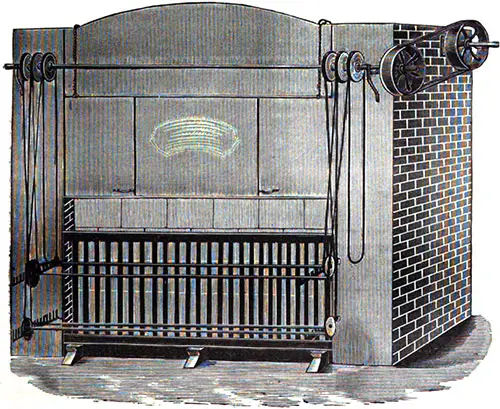
P 238
THE ROASTER with its board hearth and long spits, long hanging chains and wheels; an endless chain with a weight sufficiently heavy to rotate it, steam, electricity or hydraulic pressure can to be used advantageously to attain the same end.
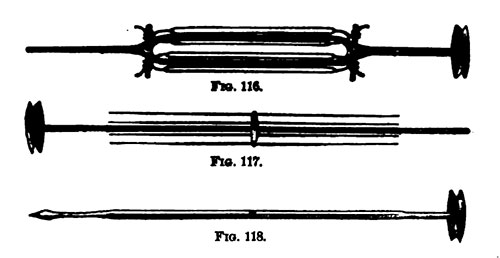
Fig. 117 represents a roasting spit for small game, quails, woodcocks, thrush, etc. It is provided with six skewers; run the game on to one of these through the two leg bones; use as much as possible the different sides for different games, for instance, one side for quails, partridges or thrush and the other three skewers for snipe, woodcock, plovers, bustards, etc.
These spits are very useful for large dinners, for eight quails can be put on each skewer or forty-eight quails can be roasted at once without having them too crowded.
The length of the spit is sixty-eight inches, and the length of each one of the six skewers is twenty inches.
For cradle spit Fig. 116, the cut of meat to be roasted such as loin, the saddle is placed exactly in the center to regulate the weight evenly. The simple spit for poultry, game, turkey, etc. is shown in Fig. 118. A spit being at times an impossibility, one is frequently obliged to have a resource to the more simple roasters.
The greatest objection to the old-fashioned shell roaster is that the spit did not turn alone; it had to be everlastingly turned for, if left, the meat would certainly spoil. A great improvement on this is the turning spring spit to be wound up like a clock and strikes an alarm when slackening by the movable balls of the fan striking on a gong (Fig. 119 below).
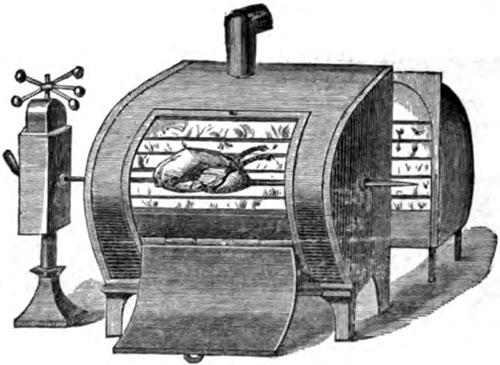
There are other roasters having two spoons turning at the same time as the spit feeding a small reservoir found on the top of the spit and through a shallow furrow perforated by small holes, the meat is continuously basted. The three pieces composing this
oven are movable and can, therefore, be transported to any desirable place; the shell can easily be fastened on to the wall.
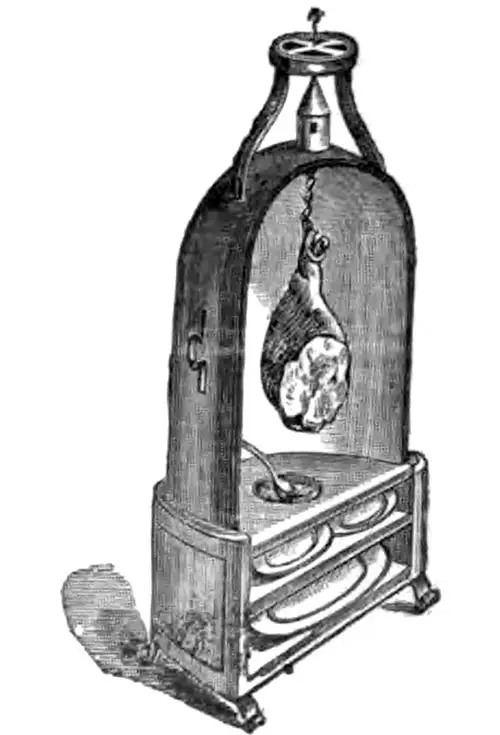
There are also English spits adapted for all hearths (Fig. 120); it is easy to fasten it to a movable hearth fitting with the spit. These are run by clockwork placed on top; the roasts are suspended perpendicularly and always turn in the same direction.
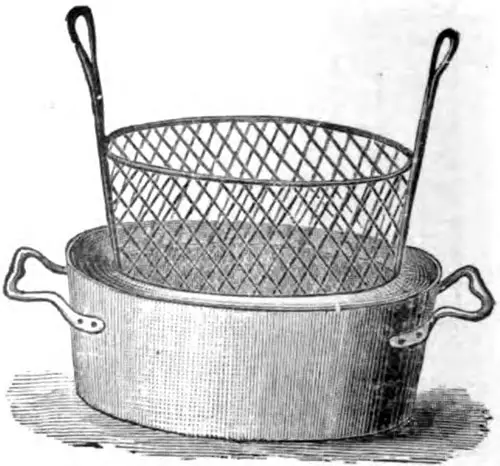
Fig. 121 represents a wrought or sheet iron pan; the interior has a basket which is used for frying small fish, potatoes, croquettes, etc. Place inside the objects intended for frying and plunge the basket into the frying fat after it has attained the required heat; the articles being cooked and of a fine color, withdraw the basket to drain them properly.
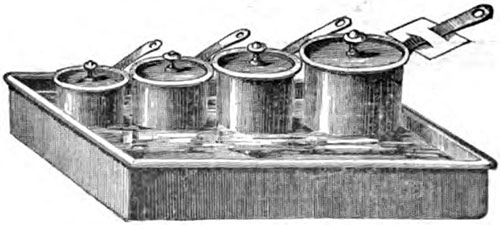
Fig. 122 represents a copper case containing four high saucepans called bain-maries. A bain-marie consists of a vessel filled with boiling water into which is placed another vessel containing the substances that are required to be heated.
The materials placed in the second vessel can only acquire the temperature of the boiling water and heat gradually and progressively and therefore can be stopped at any time. Each saucepan should be ticketed with the name of the sauce it contains so that any sauce or soup can be selected without wasting time in searching for it
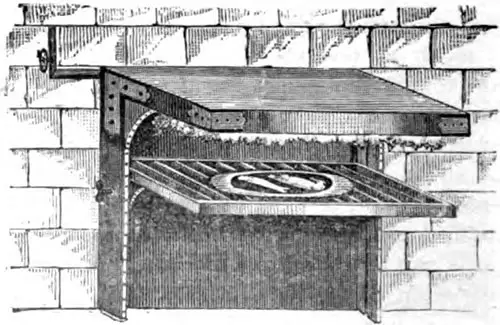
Fig. 123. The salamander and oven used in kitchens to glaze or brown dishes presented difficulties on account of the attention and watchful care it necessarily required. By means of the new gas salamander, fish can be almost instantaneously glazed when covered with a well thickened or buttered sauce without any danger whatever of having the sauce curdle.
This salamander is lighted by gas and can be fastened to the wall at the back of the range. It consists of two platforms, the upper one fixed and the lower one movable and sufficiently big to place the largest dishes on it.
Naturally, the gas comes from the top, and it is easy to regulate its intensity by a stopcock. Two minutes suffice to obtain a perfect glazing without having the bottom of the dish attain the slightest heat; thus the sauce cannot deteriorate whatever. It is an indispensable utensil and assists the cook greatly both as regards its usefulness and speed.
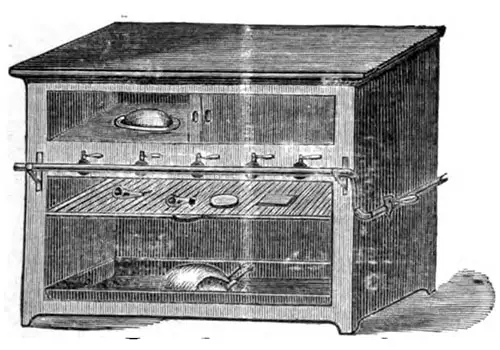
Fig. 124 is the reproduction of a very useful broiler, offering numerous facilities for various purposes. The broiling takes place in a metal case, it being provided with five gas tubes, having the sides bored with small holes, the gas projects into small bells to have it purified and then can be used for broiling without the annoyance of smell nor smoke.
It is principally used for broiling toasts, canapés, or toasts for sandwiches; meats can also be broiled thereon such as cutlets, chops, and beefsteaks.
When the bottom is closed with a movable door, it can be used for roasting chickens, legs of mutton, beef, etc. The top part is useful for keeping things hot. All gas stoves can be regulated and moderated, according to the work, by modifying or increasing the volume of gas.
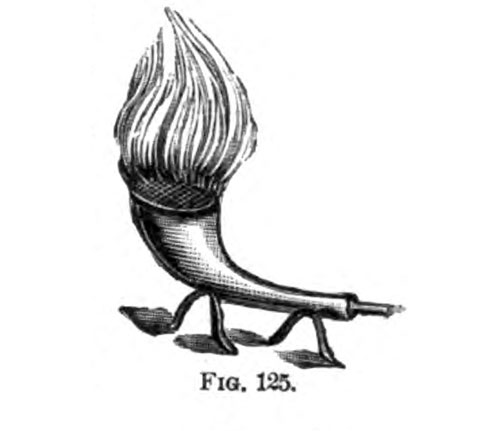
Fig. 125 shows a singeing apparatus shaped like a horn; the largest part, from whence issues: the flame is covered with a very fine metallic cloth which causes the flame to become enlarged.
There is an opening on the other or thin end about an inch in diameter for the purpose of combining the air with the gas, forming a Bunsen burner. Poultry and game can be singed without blackening the skin whatever.
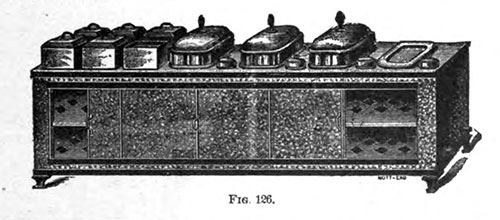
Fig. 126 is a steam table with covered dishes, cases, and bain-maries. The square boxes are used for soups, stews, etc.; the covered dishes for large pieces of meat to be carved and for entrées; the small steamers are for keeping the sauces and gravies.
Instead of a dish on the right, place a carving-board with a knife and fork. The inside is used for keeping the dishes hot before and after they are dressed. These steam tables are heated by steam or gas, and are advantageously used either as a hot closet or as a substitute for a chafing dish.
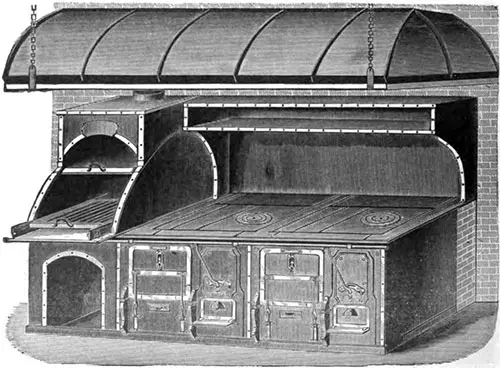
BROILER AND RANGE
The broiler shown below is most useful, for on it can be cooked all meats, either using charcoal, or embers, or gas. In olden times meats were broiled on the embers of a chimney hearth, fanning continuously to keep the fire alive.
For many years sliding broilers have been used and charcoal. With gas, the broiling is done in a metal case, by a gas tube having the sides pierced with small holes.
Although gas is very little used in kitchens still it deserves to be encouraged; for not only does this style of broiling interest amateurs by its ingenuity, but it also has its particular advantages which are manifold, as the operation takes place without the slightest trouble and without having the meats give forth any smoke or disagreeable smell, for the heat attains the meat from the top, and all the escaping fat falls into a receptacle. Fig. 127 shows an improved range an explanation of which is unnecessary.
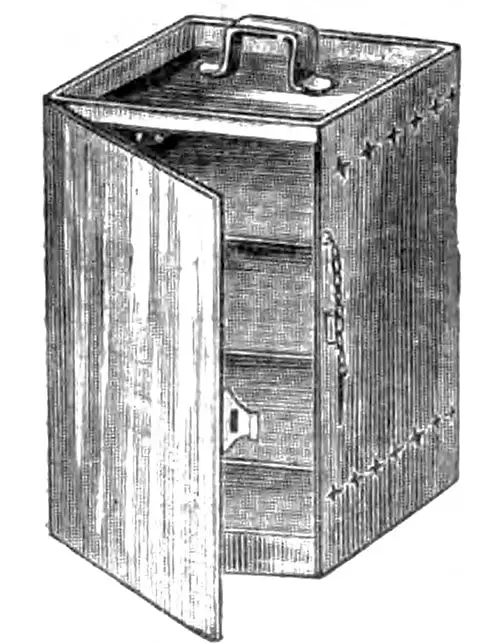
PORTABLE HEATER
This heater is used for transporting meats outside or keeping hot dishes to be served. It is heated with small cakes of prepared coal, made red hot in the hearth of the range, then put into a small sheet-iron box placed at the bottom of the heater. It can also be heated with an alcohol lamp.
The heaters are made of tin and provided with two gratings inside; they can be of any size (Fig.128).
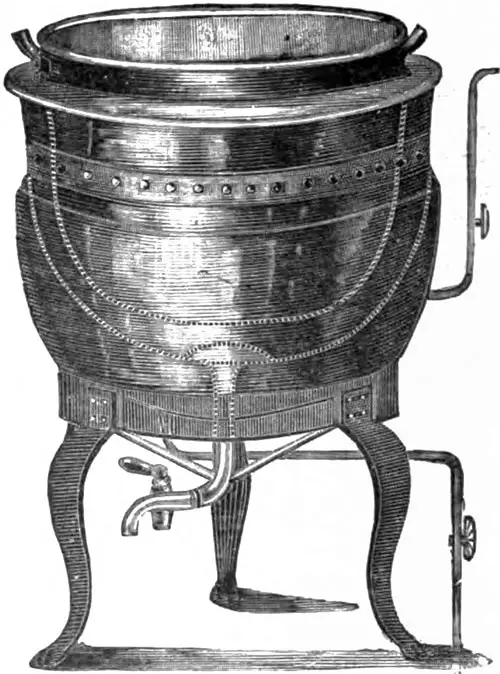
STEAM KETTLE WITH DOUBLE JACKET
Fig. 129. A steam double bottom kettle either having a ball in the center or else a winding pipe. In this same shaped pot, all systems can be employed.
The one shown on the figure has a double jacket; on top place a ring and in this a tinned basin; fill it half full of boiling water and use it for cooking ices; stocks, broths, and consommés are cooked in those having a ball in the center, or else a winding pipe, but the ball is preferable.
For cooking potatoes, lobsters, terrapin, etc., iron pots with rounded corners are used; on the bottom is an iron winding pipe furnished with holes: at the bottom is a hole for letting the water from the condensed stream run out, on top a hinged cover sufficiently heavy to close it hermetically, specially required for these kinds of pots.
MOLDS
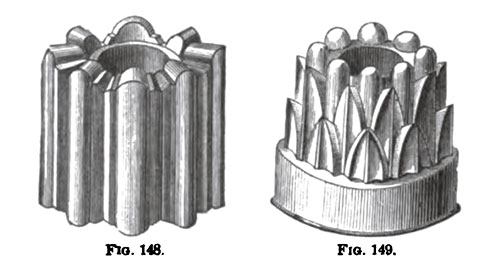
Cream Mold - Made of tin or copper; they are fancy and cylindrical. Used for molding cold creams, pains of fruits, blanc manges, etc. (Fig. 148).
Jelly molds are made both of copper, tinned in the inside, fancy and cylindrical, and are used for thick creams, blanc manges, flamris, etc. Three or four are not too many to have in a kitchen.
Baba molds are of copper, tin and earthen-ware; they are cylindrical shaped and generally have deep furrows in them, but can be of any shape (Fig. 149).
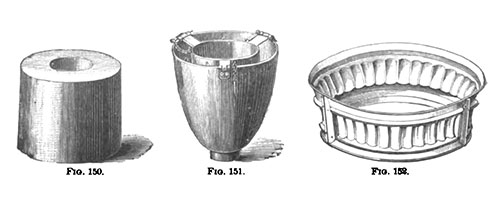 “Pain" and Pudding Cylindrical Molds
“Pain" and Pudding Cylindrical Molds
These are cylindrical shaped, tinned on the inside. Generally puddings are cooked in these molds, but they can also be used for rice or fruit pains, besides they are very useful in a kitchen either for hot entrées or else molding hot or cold sweet dishes. Dome shaped molds can also be used to poach pains and puddings (Fig. 150).
Fig. 151 is a copper mold, tinned inside and outside, the double bottom is removable and is kept at an even distance from the edges and bottom by three catches fastened to it. It can be used for cold dessert creams; the same mold without the double bottom, but having a cover fitted on the outside can be utilized for hot or cold puddings.
Fig. 152 represents a tin mold for making paste croustades and can also be used for molding rice or hominy.
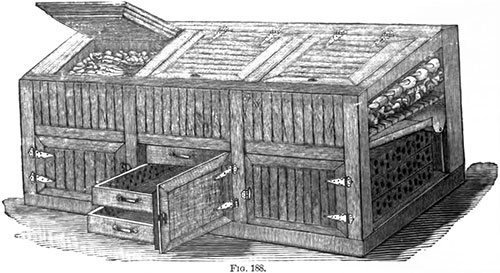
REFRIGERATOR, ICE-BOX AND COLD ROOM
P 252
These refrigerators are to be kept full of ice so to reduce the temperature inwardly and to avoid inconvenience arising from the excessive heat of the atmosphere. A refrigerator as shown in the accompanying design is all that is necessary for a restaurant, etc.
At a third of its height are placed wooden gratings to uphold the ice, underneath is to be found a sheet of zinc or galvanized sheet iron with a small gutter, in the end, between this and the sheet of iron is a space of six inches.
The bottom parts of these ice-boxes are used for keeping either beef palates, calf's heads, sheep's trotters, croquette preparations of all kinds, etc.; each compartment should be entirely separate from one another, having a special one for fish, one for poultry, one for game, one for cold meats, one for garnishings, etc.
The Icebox is simply a box of an oblong shape sufficiently thick to be filled with a non-conducting material such as charcoal, sawdust, tow, or simply a hermetically space not to allow the air to pass through the box; they are lined inside with galvanized sheet iron or zinc.
The cold room is of a more modern invention, the meats being hung up in the inside. Cooked meats, also different provisions requiring a cold temperature of forty-five to fifty degrees Fahrenheit, such as butter, milk or cream, rest on shelves or in drawers, without being in direct contact with the ice, for it is evident that the cold air surrounding these provisions does not contain the slightest moisture that might destroy their properties.
Another advantage the cold room has is that a number of cold entrées or sweet dishes already decorated with the jellies that are to be served will keep in perfect condition for a few days, while those placed directly on the ice do not afford the same security.
However, each one has its own peculiar advantages and one must not be sacrificed for the other, on the contrary in all large kitchens each one has its own place and both have become indispensable.
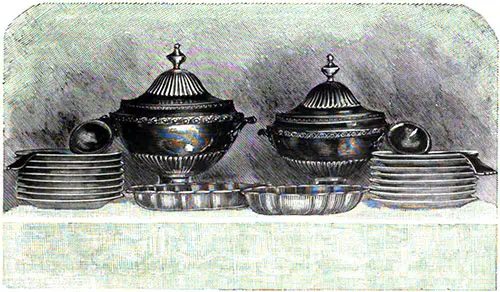
P 254 – Soup Tureens 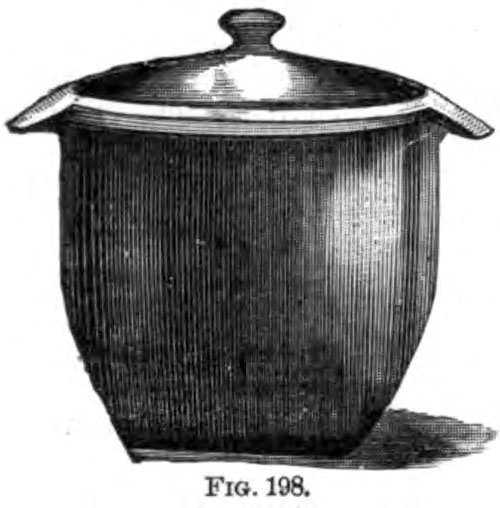
p 294 - Small Individual Soup Pot which contains a little over a pint.
"Kitchen Utensils" in The Epicurean 1916
